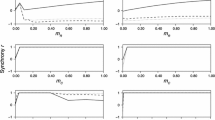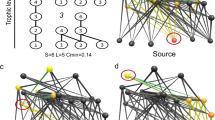Abstract
Temporally variable and reciprocal subsidies between ecosystems are ubiquitous. These spatial flows can generate a suite of direct and indirect effects in local and meta-ecosystems. The focus of most subsidy research, however, has been on the response of consumers in recipient ecosystems to constant subsidies over very short or very long time scales. We derive a meta-ecosystem model to explicitly consider the dynamic feedbacks between local ecosystems coupled through reciprocal pulsed subsidies. We predict oscillating reinforcing and dampening effects of reciprocal pulsed herbivore flows. Maximum reinforcing effects between reciprocal pulsed herbivore flows occur when these flows are in phase with the dynamics of neighboring predators. This prediction is robust to a range of pulse quantities and frequencies. Reciprocal pulsed herbivore subsidies lead to spatial and temporal variability in the strength of trophic cascades in local and meta-ecosystems but these cascading effects are the strongest when reciprocal pulsed subsidies are temporally concentrated. When predators demonstrate a behavioral response to prey abundance, reciprocal pulsed subsidies dampen the strength of local trophic cascades but lead to strong trophic cascades across local ecosystems. The timing of reciprocal pulsed subsidies is a critical component that determines the cascading effects of spatial flows. We show that spatial and temporal variabilities in resources and consumers can have a significant influence on the strength of cascading trophic interactions; therefore, our ability to detect and understand trophic cascades may depend on the scale of inquiry of ecological studies.





Similar content being viewed by others
References
Abrams PA, Holt RD, Roth JD. 1998. Apparent competition or apparent mutualism? Shared predation when populations cycle. Ecology 79:201–12.
Abrams PA, Matsuda H. 1996. Positive indirect effects between prey species that share predators. Ecology 77:610–16.
Anderson WB, Wait DA, Stapp P. 2008. Resources from another place and time: responses to pulses in a spatially subsidized system. Ecology 89:660–70.
Andrews ED, Antweiler RC, Neiman PJ, Ralph FM. 2004. Influence of ENSO on flood frequency along the California coast. J Clim 17:337–48.
Baxter CV, Fausch KD, Saunders WC. 2005. Tangled webs: reciprocal flows of invertebrate prey link streams and riparian zones. Freshwat Biol 50:201–20.
Borer ET, Seabloom EW, Shurin JB, Anderson KE, Blanchette CA, Broitman B, Cooper SD, Halpern BS. 2005. What determines the strength of a trophic cascade? Ecology 86:528–37.
Burcher CL, Valett HM, Benfield EF. 2007. The land-cover cascade: relationships coupling land and water. Ecology 88:228–42.
Gratton C, Denno RF. 2003. Inter-year carryover effects of a nutrient pulse on Spartina plants, herbivores, and natural enemies. Ecology 84:2692–707.
Gratton C, Vander Zanden MJ. 2009. Flux of aquatic insect productivity to land: comparison of lentic and lotic ecosystems. Ecology 90:2689–99.
Gravel D, Mouquet N, Loreau M, Guichard F. 2010. Source and sink dynamics in metaecosystems. Ecology 91:2172–84.
Hastings A. 2004. Transients: the key to long-term ecological understanding. Trends Ecol Evol 19:39–45.
Holt RD. 1977. Predation, apparent competition, and the structure of prey communities. Theor Popul Biol 12:197–229.
Holt RD. 2008. Theoretical perspectives on resource pulses. Ecology 89:671–81.
Holt RD, Barfield M. 2003. Impacts of temporal variation on apparent competition and coexistence in open ecosystems. Oikos 101:49–58.
Holt RD, Lawton JH. 1994. The ecological consequences of shared natural enemies. Ann Rev Ecol Syst 25:495–520.
Howeth JG, Leibold MA. 2008. Planktonic dispersal dampens temporal trophic cascades in pond metacommunities. Ecol Lett 11:245–57.
Huxel GR, McCann K. 1998. Food web stability: the influence of trophic flows across habitats. Am Nat 152:460–9.
Knight TM, McCoy MW, Chase JM, McCoy KA, Holt RD. 2005. Trophic cascades across systems. Nature 437:880–3.
Leroux SJ, Loreau M. 2008. Subsidy hypothesis and strength of trophic cascades across ecosystems. Ecol Lett 11:1147–56.
Leroux SJ, Loreau M. 2010. Consumer-mediated recycling and cascading trophic interactions. Ecology 91:2162–71.
Loreau M, Mouquet N, Holt RD. 2003. Meta-ecosystems: a theoretical framework for a spatial ecosystem ecology. Ecol Lett 6:673–9.
Marczak LB, Thompson RM, Richardson JS. 2007. Meta-analysis: trophic level, habitat, and productivity shape the food web effects of resource subsidies. Ecology 88:140–8.
Massol F, Gravel D, Mouquet N, Cadotte MW, Fukami T, Leibold MA. 2011. Linking community and ecosystem dynamics through spatial ecology. Ecol Lett 14:313–23.
McCann KS, Rasmussen JB, Umbanhowar J. 2005. The dynamics of spatially coupled food webs. Ecol Lett 8:513–23.
McCann KS, Rooney N. 2009. The more food webs change, the more they stay the same. Phil Trans R Soc B 364:1789–801.
McCoy MW, Barfield M, Holt RD. 2009. Predator shadows: complex life histories as generators of spatially patterned indirect interactions across ecosystems. Oikos 118:87–100.
Nakano S, Murakami M. 2001. Reciprocal subsidies: dynamic interdependence between terrestrial and aquatic food webs. Proc Nat Acad Sci USA 98:166–70.
Neubert MG, Caswell H. 1997. Alternatives to resilience for measuring the responses of ecological systems to perturbations. Ecology 78:653–65.
Nowlin WH, Vanni MJ, Yang LH. 2008. Comparing resource pulses in aquatic and terrestrial ecosystems. Ecology 89:647–59.
Paetzold A, Schubert CJ, Tockner K. 2005. Aquatic terrestrial linkages along a braided-river: riparian arthropods feeding on aquatic insects. Ecosystems 8:748–59.
Polis GA, Anderson WB, Holt RD. 1997. Toward an integration of landscape and food web ecology: the dynamics of spatially subsidized food webs. Ann Rev Ecol Syst 28:289–316.
Polis GA, Hurd SD. 1995. Extraordinarily high spider densities on islands: flow of energy from the marine to terrestrial food webs and the absence of predation. Proc Nat Acad Sci USA 92:4382–6.
Post DM, Conners ME, Goldberg DS. 2000. Prey preference by a top predator and the stability of linked food chains. Ecology 81:8–14.
Sacks BN, Neale JCC. 2007. Coyote abundance, sheep predation, and wild prey correlates illuminate Mediterranean trophic dynamics. J Wildlife Manag 71:2404–11.
Schindler DE, Scheuerell MD, Moore JW, Gende SM, Francis TB, Palen WJ. 2003. Pacific salmon and the ecology of coastal ecosystems. Front Ecol Environ 1:31–7.
Schreiber S, Rudolf VHW. 2008. Crossing habitat boundaries: coupling dynamics of ecosystems through complex life cycles. Ecol Lett 11:576–87.
Semlitsch RD. 2000. Principles for management of aquatic-breeding amphibians. J Wildlife Manag 64:615–31.
Shurin JB, Borer ET, Seabloom EW, Anderson K, Blanchette CA, Broitman B, Cooper SD, Halpern BS. 2002. A cross-ecosystem comparison of the strength of trophic cascades. Ecol Lett 5:785–91.
Stibor H, Vadstein O, Diehl S, Gelzleichter A, Hansen T, Hantzsche F, Lippert B, Loseth K, Peters C, Roederer W, Sandow M, Sundt-Hansen L, Olsen Y. 2004. Copepods act as a switch between alternative trophic cascades in marine pelagic food webs. Ecol Lett 7:321–8.
Takimoto G, Iwata T, Murakami M. 2002. Seasonal subsidy stabilizes food web dynamics: balance in a heterogeneous landscape. Ecol Res 17:433–9.
Takimoto G, Iwata I, Murakami M. 2009. Timescale hierarchy determines the indirect effects of fluctuating subsidy inputs on in situ resources. Am Nat 173:200–11.
Verspoor JJ, Braun DC, Reynolds JD. 2010. Quantitative links between pacific salmon and stream periphyton. Ecosystems 13:1020–34.
Witman JD, Ellis JC, Anderson WB. 2004. The influence of physical processes, organisms, and permeability on cross-ecosystem fluxes. In: Polis GA, Power ME, Huxel G, Eds. Food webs at the landscape level. Chicago: University of Chicago Press. p 335–58.
Yang LH. 2004. Periodical cicadas as resource pulses in North American forests. Science 306:1565–7.
Yang LH, Bastow JL, Spence KO, Wright AN. 2008. What can we learn from resource pulses? Ecology 89:621–34.
Yang LH, Edwards K, Byrnes JE, Bastow JL, Wright AN, Spence KO. 2010. A meta-analysis of resource pulse-consumer interactions. Ecol Monographs 80:125–51.
Acknowledgments
The authors thank A. Hurford, R. Holt, F. Guichard, M. Scheffer, J. Shurin, and anonymous reviewers for constructive comments on the manuscript. S. Leroux was supported by the Natural Sciences and Engineering Research Council of Canada (NSERC), the Quebec Nature and Technologies Research Fund (QNTRF), and McGill University. M. Loreau was also supported by the Canada Research Chair program, a Discovery Grant from NSERC, and a team research project from the QNRTF.
Author information
Authors and Affiliations
Corresponding author
Additional information
Author contributions
SJL and ML designed the study and derived the meta-ecosystem model. SJL analyzed the model and ran the simulations. SJL and ML wrote the paper.
Electronic supplementary material
Below is the link to the electronic supplementary material.
Rights and permissions
About this article
Cite this article
Leroux, S.J., Loreau, M. Dynamics of Reciprocal Pulsed Subsidies in Local and Meta-Ecosystems. Ecosystems 15, 48–59 (2012). https://doi.org/10.1007/s10021-011-9492-0
Received:
Accepted:
Published:
Issue Date:
DOI: https://doi.org/10.1007/s10021-011-9492-0




